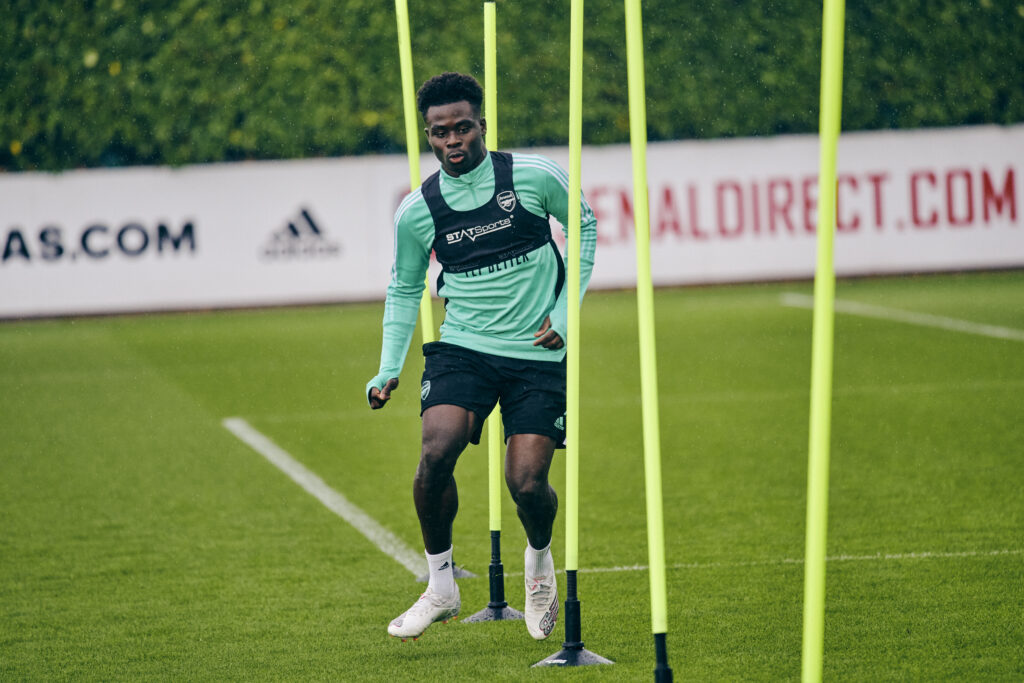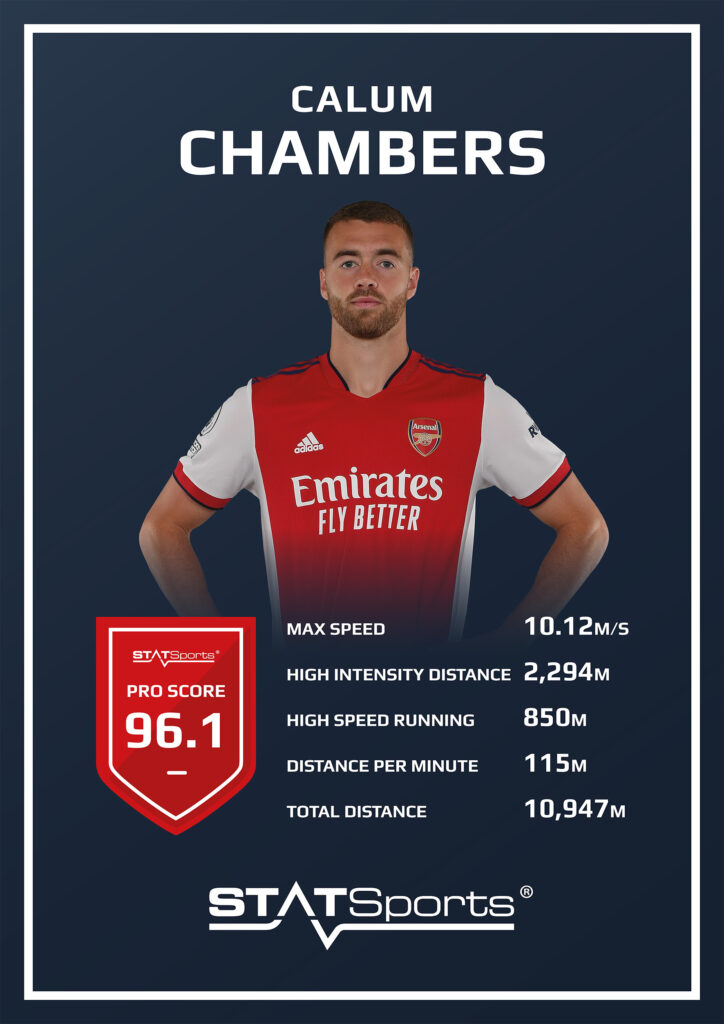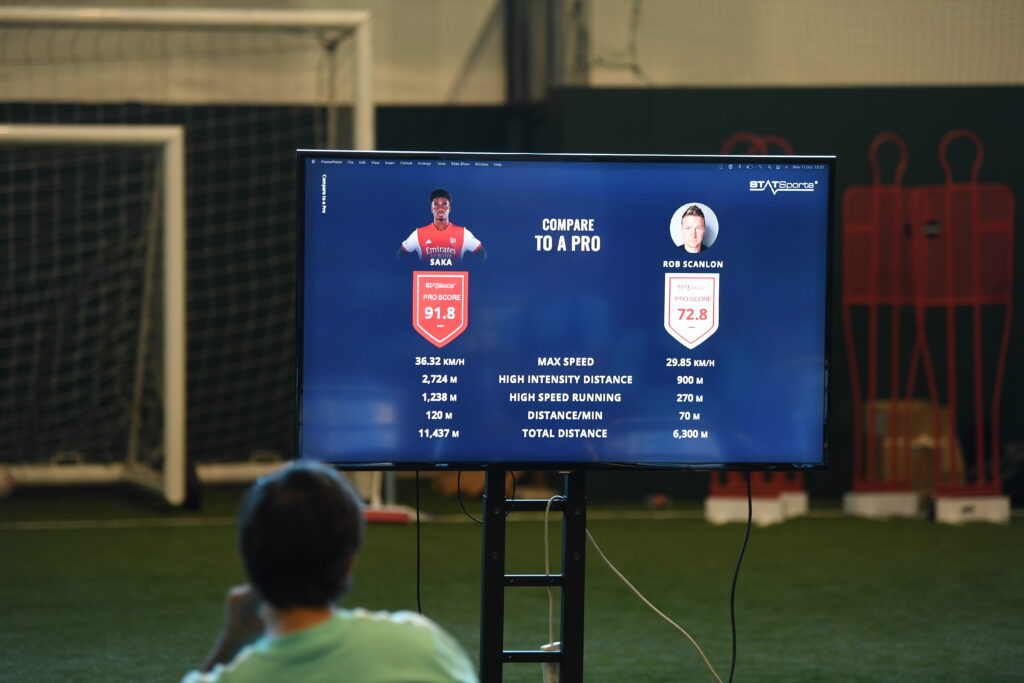Arsenal FC and STATSports have signed a partnership, through which STATSports Arsenal FC Edition will be launched on October 18th. This is the same technology and black pod the first team use to capture data from every session- you know those sports bra looking vests players wear? Well, those are used to house a little black pod that captures all their physical outputs.
Through the product, aspiring players will be able to review their own data and the data from players at all levels of the club, in the men’s and women’s teams, to help them understand where they need to improve to get to the top of their physical game.
In STATSports own words, there are hundreds of millions of amateur footballers all over the world and having forged partnerships with plenty of elite sports clubs, like Arsenal, now they want to market their product to the everyday amateur footballer.
The idea is to put physical performance data in the hands of amateur footballers, who can then compare their outputs to players from the Arsenal men’s and women’s senior and academy teams. Data can be cut by position too and the app allows you to see the average outputs in your age group set against other users.
Arseblog News was invited to London Colney to talk to Barry Watters, Head of Sports Science at STATSports and Arsenal Women left-back and left-winger Katie McCabe about the partnership and, more generally, about the use of physical data from the sports science perspective and the player’s perspective. Arseblog News was also invited to take part in some training drills and measure our data against members of the Arsenal men’s team but, alas, a chronic hip injury prevented our participation. That is our excuse and we are sticking to it.

Barry Watters, Head of Sports Science, STATSports
Football analysis, both in the media and broadcast media, has not focused enough on the physical demands on elite footballers in my opinion. In their opening presentation, STATSports emphasise that, when Joe or Joan Public compares their physical data to an elite footballer, the high intensity sprint metric is the one where even your reasonably fit punter just cannot get close to a top-flight player.
The repeatability of high-intensity sprinting (as well as, you know, talent) sets professionals apart- to constantly have to accelerate and decelerate and go again over a 90-minute period requires superhuman physicality. I ask Barry Watters whether he agrees that we don’t consider the physical side of being a player in football analysis.
“The only real physical data you get is distance covered by a team or a player but it’s without context,” Watters explains. “A player might run 10 or 11km in a game but really it’s about how you achieve that 10 or 11km. When you look at number of sprints, high intensity sprints, maximum speed achieved, I think it will allow the fan that uses the app to appreciate how good elite players are physically.
“You’ll be able to see by position too, so to compare to a winger or a full-back, a lot of high-speed running. If you are in central midfield, there will be a lot more pressing the ball, decelerating, pressing the ball again, so there’s a lot of short, sharp movements. Eventually coverage and broadcasting will get there because the data will be available, there’s a lot of tactical data at the moment but also we’ll be able to appreciate a player’s physical skillset as much as their tactical skillset.”
Data has formed a large part of the picture for elite football teams for many years now; but Watters admits that, though the journey is now at an end, there has been a journey in terms of convincing players of the benefits. “A misconception from some people about this type of technology is that it’s there to catch players out but really it’s there to help them for optimal performance.”
There have been stories over the last couple of years which have resurfaced this week over intellectual property challenges from players over the use of their performance data. STATSports are making Arsenal players’ physical data available to those that purchase the Arsenal FC Edition product. I ask Barry whether there have been any IP challenges in giving people unprecedented access to player data.

“Globally there are challenges around GDPR (General Data Protection Regulation) and IP challenges about sharing player data. When we formed this partnership with Arsenal, they talk to the players and deal with the IP perspective so there is agreement on what we share.” Watters says that there is a big appetite among amateur players for this level of data, especially in the 20-30 year-old range. Many people in this age bracket have grown up playing FIFA and Football Manager, where player data is all baked into the experience.
“Anything you watch on TV nowadays has some kind of data inserted into it,” he argues. “There is a gamification part to it too, like you might have to do a certain number of training sessions to unlock a particular feature before you get your ProScore. But we know there are plenty of young people out there who aspire to play professionally and they can compare themselves to academy players in the male or female academies to see what is required from a player in their position.”
Watters says that the way younger and more senior players, both in the professional and amateur spheres, use the data will probably vary. “With the younger players, especially the teenage players, a lot of it is about education and what these measures are and where they can develop and mature. With the older players, it can be more about recovery and controlling their load. You’re not going to make a 35 year-old twice as quick so it’s more about optimisation and checking the volumes that they are exposing themselves to.”
On the subject of more senior players, I ask Barry whether deployment of this level of data in elite clubs can begin to challenge the dreaded age curve. Players are still retiring at roughly the same age they have been since the 1960s and the estimation of a player’s typical peak years has not moved much either. Barry argues that, in real terms, the application of data already has taken on the age curve in a way that is not obvious at first glance.
“As time has gone on the demands of the game have gotten much higher and this level of data has helped to preserve the ages at which players are able to carry on, without this it might have gotten lower over time. The length of a player’s career is multi-faceted and can depend on lifestyle, injuries, recovery. The total distance run by Premier League players hasn’t really changed in the last ten years but the number of high intensity sprints they do, the amount of high speed runs has almost doubled.”
Watters says that senior players buy into the expanding application of physical data as much as young players do, maybe even more so. “At first some older players had some concern that this data would ‘expose’ them slowing down but it’s actually the opposite, we use this data to protect them and get the right recovery. They can see things that they might need to work on. The players love this data because it either reaffirms their good impressions or it helps them to look for edges and areas of improvement- it helps with injury prevention too.”
STATSsports are also working with the Arsenal Women’s team, as well as women’s teams across sports and Watters says the data can be applied for amateur female footballers in exactly the same way as it can for men. “We have the data across the women’s team and women’s academy so female footballers can compare themselves to those outputs if they want to. There’s a lot more that can be done in injury prevention for female players too, women are far more likely to rupture their ACLs and as a sports scientist, it’s an area where there is a lot of work going on that we want to tap into.”
Within professional clubs, Watters says teams will use the data in a tactical sense too. “They can use GPS to determine a team’s shape and they can take that away and analyse their shape when they score or concede goals, for example. Through the data you can also see what a player should be able to cover, so if there is a gap in your shape when you concede, you can determine whether the player should’ve been able to cover it or whether he or she was given too much to do.”
However, he jokes that STATSports are not looking to expand into other, more controversial areas of the game with the technology. “I’m not sure the GPS would be good enough for VAR or offsides but I don’t think that’s an area we want to get into at the moment!”
Katie McCabe, Arsenal and Ireland
Professional footballers are inherently competitive creatures and Arsenal and Ireland’s Katie McCabe says increased data application has amplified the competitive environment within the team. “We’ll be doing speed tests in training and you’re working your backside off and you’ll ask the S&C (Strength and Conditioning) staff what your stats were and you compare to everyone else. You get that level of competitiveness and it drives everyone to try to improve.”
This season, Arsenal have appointed Swede Jonas Eidevall as Head Coach and he has put a far greater emphasis on high pressing, I ask Katie how data application is assisting that tactical change. “We can see that in our data, for sure, our high-speed running, our max speeds. Jonas will usually meet with the S&C staff before training to set up certain drills, to see whether we need to be exposed to sprinting or pressing for example.”
McCabe moves between left-back and the left-wing for Arsenal and I ask her about the physical differences and how they show up in the data. “When I play left-back, my exposure to high-speed running will be very high, whether that’s because I am overlapping or trying to move their winger back and making space for my winger or to receive the ball myself.

“If I’m playing higher up, I am probably moving more from side to side. But the main stat I look for after a game is the high-speed running metric. That’s the stat that brings me into the game, if I haven’t done many I know I probably haven’t affected the game enough. I will look at that stat and watch my games back and analyse whether I have pushed the opposition back, whether I have made them defend me and how high up the pitch I have been able to get.”
The data is not just adopted by players but by medical and strength and conditioning staff too, where it is used as much for injury prevention as it is for maximisation. Arsenal also appointed Gary Lewin as Head of Medicine and Sports Science for the women’s team this summer and Katie says that his impact is already being felt in tandem with the data.
“Gary Lewin has really taken hold of things since he got here with Fran (Silver) and Eoin (Clarke) and just before the last international break, they showed us all a slide with our individual loads on it so we could see where we were in terms of loading. Underloading can be just as dangerous as overloading because you can still get injured if you come into a high-intensity game.”
I ask Katie which players from the squad are the most observant when it comes to their personal data- I sensed the answer might be Kim Little because when it comes to these questions, the answer is usually Kim Little. “I’m up there to be fair, I am a bit of a nerd with the data,” Katie interjects. “Kim (Little) is too, definitely. Viv (Miedema) is another, she is always very conscious of her high speeds in particular. She prides herself on being one of the fastest in the squad, maybe even the fastest.”
The amateurs
Now it’s the turn of the amateurs to take part in some training drills and compare their stats to players from the men’s team. Unfortunately, a permanent hip condition precludes Arseblog News from donning the training kit and getting involved. I think the ghost of Cliff Bastin would post better stats than your erstwhile reporter on this occasion.
The younger and fitter of the attendees take part in seven drills, a warm-up, a SAQ drill (speed, agility and quickness), individual ball control, a 1 v 1 drill, an RSA (Repeated Sprint Ability) exercise, max speed race and a five v five game. Afterwards, the breathless squadron are marched back to the indoor sports centre at Colney to compare themselves to a selected men’s team player in five key stats: max speed, high intensity distance, high speed running, distance per minute and total distance.

What really jumps out is that some participants occasionally come close to a first-team player in one metric. For example, one individual comes close to Emile Smith Rowe’s maximum speed, one gets close to Pierre-Emerick Aubameyang on total distance. Nobody gets close to any player on high intensity distance. The ability to sprint, stop, sprint, stop, sprint and stop over and over and over again separates the elite professional from even the trimmest, fittest amateur in physical terms.
It’s easy to forget that players are incredibly highly tuned professional athletes, capable of physical feats most of us just could not manage. Even set against your most dedicated gym dweller, what these players are capable of is scary. There is a reason pro athletes have to retire under 50% into their life expectancy, after all. It stands to reason that there is an increased emphasis on this area in clubs and, soon enough, we all ought to be more aware of it too.
The STATSports Arsenal FC Edition will be available to buy from 18th October.




An excellent partnership at face value but are Arseblog not nervous about the reports earlier in the week about players complaining that the data being sold by these companies is breaching GDPR legislation?
I asked that question of the STATSports guy in the piece. Nothing for the site to be nervous about cos it’s nowt to do with us!
Impressive. Simply impressive.
I’m nowhere near good enough as far as athleticism goes never mind talent/flair. I could only watch in awe and admiration, knowing I wasn’t built for this.
That said, I imagine if I dabbled, same hip injury would have kept me from this wonderful opportunity at this time. I truly get you, Blogs.
So what I’m hearing is that were it not for the lack of talent, athleticism and physical fitness, you could have been a superstar.
I can relate.
Good write up Tim that was interesting.
Kinda weird to think of checking player stats to this degree.
Another dollar for the club coffers..
Look forward to hearing this discussed on the pods
“now they want to market their product to the everyday amateur footballer”
So arsenal is perfect 👌😝
Wow, I expect some data brokers are rubbing their hands together over this.
#Ad ?
It’s a similar principle to when we get access to kit launches or invited to premiers for Arsenal based documentaries etc, they get promotion out of it, sure, we get access and (hopefully) interesting BTS content.
Fair enough, I wasn’t having a go, it’s expected in this life.
Keep them sweet
All? Ewwww.
You can compare your bowel movements with Rob Holding.
Life goal achievement, tbf.
Probably the most ethical product from these footballe web; aspiring the next gems. Enough with the soap operas shows (matchday programs) and the Disneylands (FIFA, FM, FPL,….) sell the real content of being a footballer Don’t know if Arsenal is the only as yet, but Arsene sold the world a football package based on the movement of atoms in a closed state by external force. Is it Brownian motion of atoms. ……(a pitch and 22 players plus officials and basic rules of engagement) and we had the best days of our lives. This is good esp since Arsenal has said… Read more »
Thanks for covering this Tim, it’s a really interesting piece. However, it does raise the question as to the cost/benefit of these data methods. I see the GPS tracker itself is listed at around USD 300, and I’m guessing the cost of the data package is additional, and differentially priced/packaged for corporate clients. For this, it sounds like their only semi-mature statistical product revolves around speed and distance. I’d venture clubs are already aware that players who can accelerate quickly, hit a high top speed, decelerate and turn, and do this for 90 minutes 50 times a year are highly… Read more »
Why is there high Street shops selling 50kinds of football boot? It’s the illusion of professional tools = professional person.
Whereas most of us amateurs are closer to ‘all the gear but no idea’s